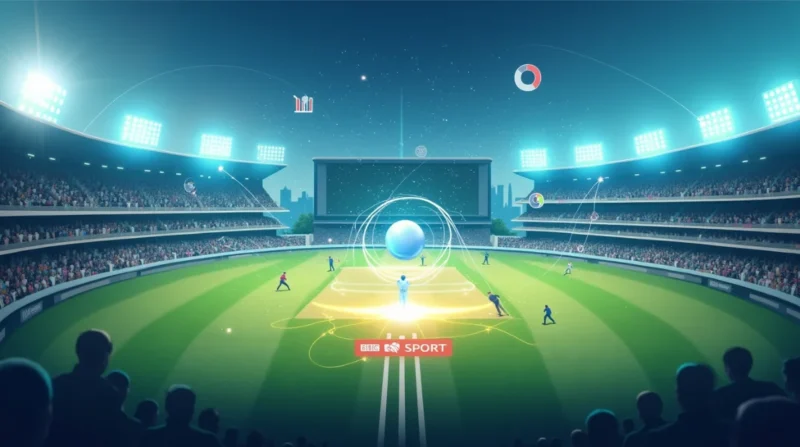Table of Contents
- What is Data Analytics in Cricket?
- How BBC Sport Cricket Integrates Analytics?
- Popular Data-Driven Tools in Cricket
- Statistical Models in Match Predictions
- Role of Impact Metrics
- Real‑Time Match Enhancements
- How Teams and Broadcasters Use Analytics?
- Why BBC Sport Cricket Focuses on Analytics?
- Challenges & Limitations
- The Future of BBC Sport Cricket Analytics
- Conclusion
In the world of BBC Sport cricket, data analytics is no longer just a buzzword, it’s a game-changer. From predicting match outcomes to helping fans understand complex strategies, data now plays a central role. This article discuss how analytics transforms cricket predictions, explains key tools, and highlights BBC Sport’s evolving approach. By the end, you’ll truly understand why data is revolutionizing cricket coverage today.
What is Data Analytics in Cricket?
Data analytics in cricket involves gathering large amounts of match information such as player stats, ball trajectories, pitch conditions, and weather data and using it to uncover patterns and trends. Analysts apply tools like regression models, machine learning, and AI systems to predict match outcomes, evaluate player performance, and optimize team strategies.
Why does it matter for BBC Sport Cricket?
- Enables clear, insightful storylines and statistics.
- Boosts engagement through visually compelling data presentations.
- Helps fans feel closer to the action and more informed.
How BBC Sport Cricket Integrates Analytics?
AI and Machine Learning
BBC Sport has increasingly relied on AI-driven insights, similar to its approach in European football coverage, linkedin.com, and sportspro.com. In cricket, this includes models like:
- Regression models (e.g., linear, ridge) for predicting first-inning scores during games.
- Random Forest and SVM classifiers to forecast match winners with impressive accuracy, youtube.com, arxiv.org.
Ball‑by‑Ball Live Prediction
Techniques like Long Short-Term Memory (LSTM) models are used to continually update win probabilities as each ball is bowled, providing dynamic match insights
at arxiv.org.
Advanced Tools & Visuals
BBC often utilizes systems such as Hawk-Eye, Decision Review System (DRS), and WASP for intelligent match predictions and reviews theguardian.com, en.wikipedia.org, en.wikipedia.org. These tools power on-screen graphics and enhance the overall viewing experience.
Popular Data-Driven Tools in Cricket
Hawk‑Eye
A vision-based system using multiple cameras to track ball trajectory, bringing transparency to decisions like LBW.
Decision Review System (DRS)
An umbrella tech using Hawk‑Eye, Snicko, Hot Spot, and other tools to allow players to challenge umpire rulings.
WASP (Winning and Score Predictor)
A predictive model that calculates likely scores or win chances based on balls left, wickets in hand, pitch conditions, and more.
Statistical Models in Match Predictions
Regression Models:
- Linear regression predicts the final first innings score as the match unfolds.
- Ridge and Lasso regression refine these predictions by avoiding overfitting.
Classification Models
- Random Forest, SVM, and Naïve Bayes are used to forecast match winners or individual player contributions, Random Forest often proving most accurate (70–88% success).
LSTM Networks
- These neural networks can predict outcome probabilities on a ball-by-ball basis, critical in shorter formats like T20.
Role of Impact Metrics
Impact Data
BBC and other cricket boards analyze not just performance, but contribution to match outcomes (e.g., clutch innings, pressure scenarios).
Impact Index (ESPNcricinfo)
A system that rates players based on impact rather than plain stats, featured on BBC platforms.
Real‑Time Match Enhancements
In‑Match Prediction Widgets
BBC Sport can display “probability of winning” live, updating with every ball due to LSTM or WASP tools (% chance of chase success, projected innings totals).
Tactical Broadcast Graphics
Analytics help broadcasters steer game narratives, such as “momentum shifts” or “match-up battles,” using system insights (e.g., CricViz).
Enhanced Fan Engagement
Fans understand deeper strategies, learn insights, and root for analytics-backed outcomes, making the game more interactive and educational.
How Teams and Broadcasters Use Analytics?
Team Side
- Franchise teams (e.g., IPL) use CricViz, Hawk-Eye, wearable sensors, and biomechanical data to shape tactics, select squads, and manage fitness.
- The England Cricket Board uses systems like iHawk to track domestic performances and assess suitability for international matches, thetimes.co.uk.
- Performance analysts like Prasanna Agoram use data insights to elevate national team approaches. en.wikipedia.org.
Broadcaster Side
- BBC Sport incorporates this data into graphics and commentary.
- Tools like AI‑generated predictions and DRS visuals add depth for viewers.
- Interactive segments (e.g., predicting the next ball outcome) engage audiences directly.
Why BBC Sport Cricket Focuses on Analytics?
- Clear Storytelling: Data adds clarity to narratives (“He thrives under pressure,” “Win chance dropped suddenly after that wicket”).
- Enhanced Trust & Credibility: Using proven statistical tools ensures fairness and a more informed broadcast.
- Deeper Engagement: Users can follow tactics and trends with visual tools and contextual overlays.
- SEO & Visibility: Content with keywords like “BBC Sport cricket data analytics” draws engaged users and ranks better, thanks to rich visuals and AI‑driven summaries.
Challenges & Limitations
- Quality of Data: Accuracy depends on consistent, timely data. Input errors (e.g., ball trajectories, pitch readings) affect predictions.
- Context & Interpretation: Stats need to match context, ground conditions, weather, and player health to be meaningful. Pure metrics without context (like older amateur visuals on the BBC) can mislead.
- Technical Complexity: Machine learning models require expert handling; without maintenance, they may give unreliable predictions or overfit historical trends.
- Over‑Reliance: Excessive trust in numbers can neglect human elements like team morale, player form, and pitch behaviour.
The Future of BBC Sport Cricket Analytics
- AI‑Driven Live Commentary: Imagine AI summarizing key moments, explaining probable strategies in real time, and generating instant post‑match reports.
- Personalized Fan Experiences: Users may get custom dashboards, e.g., “Your win‑probability scroll” based on how a specific player performs.
- Deeper Integration of Wearables: As player fitness data feeds into models, real‑time fatigue analytics will predict performance dips.
- Interactive Match Tools: Live polls and model‑based “predict the outcome of next over” features can make viewing more interactive.
- Ethical Data Use: Privacy and fair usage guidelines will become essential when collecting player biometric and movement data.
Conclusion
In BBC Sport cricket, data analytics has shifted from a nice‑to‑have feature to a central element of coverage, interpretation, and fan engagement. With AI, predictive models, and advanced tech tools like WASP, Hawk‑Eye, and CricViz, analytics enriches every aspect of the broadcast from pre‑match insights through post-match analysis. Yet the human blend of commentary, context, and critical thinking remains vital. As technology evolves, BBC Sport is poised to deliver even more accurate, engaging, and interactive cricket coverage for fans around the globe. By focusing on clear explanations, visuals, and user empowerment, BBC Sport Cricket sets a new standard in how sports are told. Whether you’re a casual viewer or hardcore analyst, data makes the game more understandable and enjoyable.









